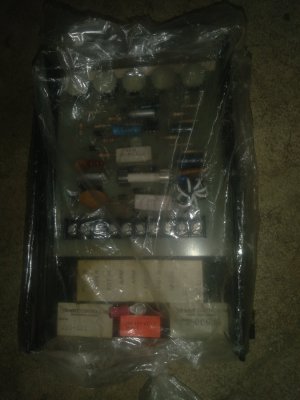- Joined
- Dec 9, 2021
- Messages
- 735
I have a motor from a 6R-A Bridgeport power feed. Actually, I have most of the parts for the unit, without the control board and its enclosure. I would like to test the motor to see if it works.
The data plate says:
Boehm
BM 9838 (maybe 983B)
Spec. No. 4640
Amps 4.6
Volts 90 DC A
100 DC B
Checking the wires, from Black to Red gives 3.8 to 4.5 Ohms
From White to Green produces a slight voltage when the armature is turned by hand, but essentially no resistance.
There is no continuity to the case from any wire.
I can rig up some batteries to produce 24, 36, and maybe 48 volts DC. Could this be enough to check the motor for function? I believe that the Black and Red wires go to the armature and the White and Green wires connect to the field coils. The field coils apparently control the direction of rotation. Apparently, the controller regulated the armature separately from the field coils to control speed and direction. I only need to see if it will turn at a speed that would be expected for the voltage input.
It looks like the controller died and the prior owner(s) just removed it and left the rest of the unit hanging on the end of the table, so I have hope that the motor is good.
The data plate says:
Boehm
BM 9838 (maybe 983B)
Spec. No. 4640
Amps 4.6
Volts 90 DC A
100 DC B
Checking the wires, from Black to Red gives 3.8 to 4.5 Ohms
From White to Green produces a slight voltage when the armature is turned by hand, but essentially no resistance.
There is no continuity to the case from any wire.
I can rig up some batteries to produce 24, 36, and maybe 48 volts DC. Could this be enough to check the motor for function? I believe that the Black and Red wires go to the armature and the White and Green wires connect to the field coils. The field coils apparently control the direction of rotation. Apparently, the controller regulated the armature separately from the field coils to control speed and direction. I only need to see if it will turn at a speed that would be expected for the voltage input.
It looks like the controller died and the prior owner(s) just removed it and left the rest of the unit hanging on the end of the table, so I have hope that the motor is good.


